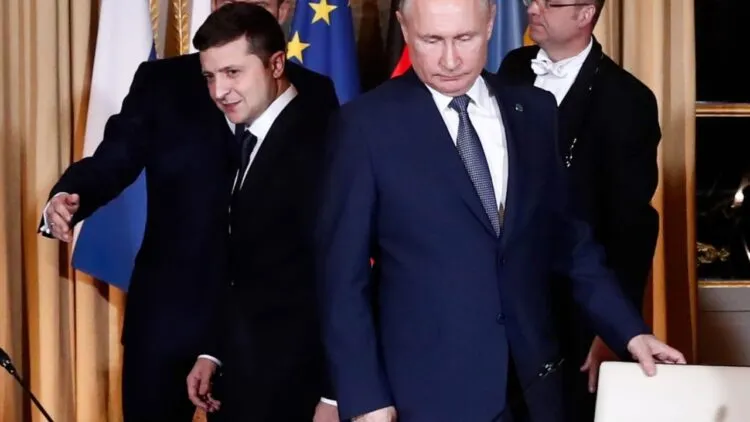Ukrainian counterpart Volodymyr Zelensky and Russian President Vladimir Putin
It is undeniable that the pace of the conflict in Ukraine is escalating rather than cooling down, particularly in light of the Kremlin’s announcement that Russian President Vladimir Putin signed a decree on Thursday evening recognising the “independence” of the Ukrainian regions of Kherson and Zaporizhia.
After declaring that Donetsk’s land border with Russia will be eliminated once it joined the Russian Federation, the separatist commander in the Ukrainian region of Donetsk made the statement.
The official annexation of these two Ukrainian territories to Russia will be made possible by the second step—recognizing the independence of these two regions—following the acknowledgment of the Donetsk and Luhansk regions’ independence prior to the beginning of Russia’s invasion of Ukraine last February.
Before the Russian president can announce on Friday that these regions “become part of Russia,” this proclamation is a requirement.
“The Russian presidency had declared on Thursday that Russia would approve the annexation of the Ukrainian territories it controls on Friday during a ceremony in the Kremlin at which Putin will give a speech.
Dmitry Peskov, the chief of Russia’s press office, said to reporters: “At 15:00 (12:00 GMT), the Kremlin will host the signing ceremony for the documents annexing the new regions to the Russian Federation.
“President Vladimir Putin will make a significant address at this time,” he continued.
This declaration follows the holding of a “referendum” on annexation in the four Ukrainian provinces of Donetsk, Luhansk, Kherson, and Zaporizhia, which are all or largely under the control of Moscow.
These referendums were labelled “fake” by Western nations and Kiev, who further emphasised that they would not recognise the annexation of these regions.
Russia’s annexation of the Crimean peninsula in southern Ukraine in 2014 is not acknowledged internationally.
Russian invasion of Ukraine has intensified as a result of the takeover of Ukrainian areas.
The Minsk II agreements of the settlement, which were signed between Moscow and Kiev in 2015 in an effort to halt the conflict that broke out in the Donbass region in southeast Ukraine, are violated by Russia’s acknowledgment of the “independence” of these Ukrainian regions.
The Ukrainian Foreign Ministry had previously stated that it believed that such a move by Moscow would amount to “Russia’s effective withdrawal from the Minsk agreements with all the legal ramifications that this involves.”
More than 13,000 people have died in combat between government forces and pro-Russian separatists in Donbass, in eastern Ukraine, since 2014.
On September 5, 2014, in the Belarusian city of Minsk, an agreement was struck between Russia and Ukraine to halt the conflict, but it never materialised. On February 12, 2015, the two sides finally decided to sign a second agreement, known as “Minsk 2,” but this did not put an end to the conflict or the fighting.
For his part, Volodymyr Zelensky requested an emergency conference of top military and security officials on Friday, according to Serhiy Nikiforov, a spokesman for the Ukrainian president.
The request came after the Kremlin announced that Putin will formally annex four regions of Ukraine on Friday as a result of local authorities-organized referendums.
After the Russian president threatened to use nuclear weapons to defend these four territories, the Kremlin said that Russia will formally annex them.
The Ukrainian forces launched a massive counterattack, forcing the Russian soldiers to retreat in the east, and moved closer and closer to Lyman, a city in the Donetsk region that Moscow forces bombed for weeks before taking control of during the summer. Despite the Russian threats, the Ukrainian forces were unable to stop their advance.
US Secretary of State Anthony Blinken stated in a statement on Thursday that “the phoney Kremlin referendums are a failed attempt to cover up what amounts to a another attempt to take territory in Ukraine.”
Following the referendums, Ukraine believed that the only proper Western response would be to increase sanctions against Russia and arm Ukrainian forces with more weapons to enable further advancement.
Ukrainian President Volodymyr Zelensky stated that “Ukraine cannot tolerate any Russian attempts to seize any portion of our land.”
The four areas, Kherson, Zaporizhia, Donetsk, and Luhansk in the south, and Crimea, which Moscow annexed in 2014, form a crucial land corridor between Russia and Crimea.
Together, the five regions make up around 20% of Ukraine’s total area, and for weeks, government forces have been retaking a number of locations.
Residents of freshly retaken villages described to AFP journalists this week the events of months of horror they endured under Russian captivity as Ukrainian forces retook territories close to Kherson in the south.
In Visokopelia, Maria Sijok, 72, claimed, “We were plundered and humiliated,” as distant artillery fire from both sides could be heard.
Military analysts report that the Ukrainian army is near to regaining Lyman while also making progress, particularly in the Kharkiv region in the east and Donetsk.
“The army has been attempting to besiege the city repeatedly. Currently, any attacks can be repelled by our soldiers “Alexei Konorov, a pro-Russian official in the Donetsk area, said on state television on Thursday.
What does it imply that Russia has acknowledged the “independence” of two areas of Ukraine?

